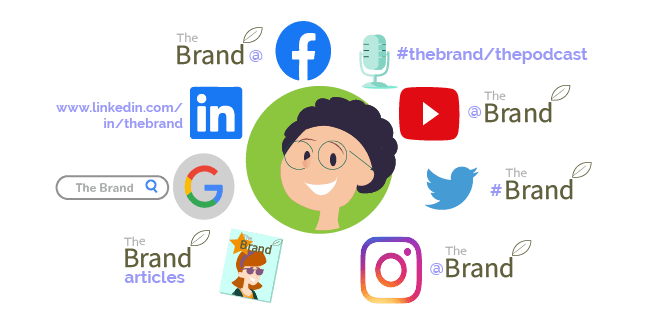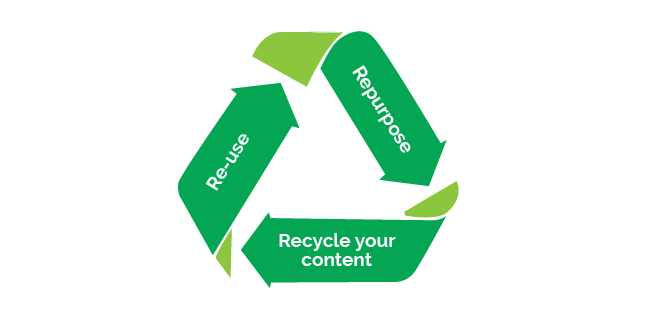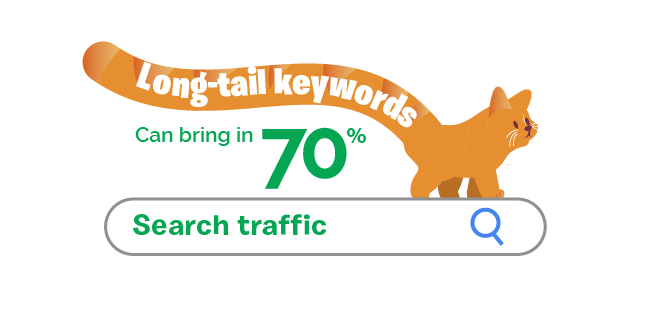Everybody is doing content marketing.
Whether you’re a billion-dollar business like Red Bull, or a local café owner, almost everybody and their dog now owns a blog.
To date, out of the 1.7 billion websites which exist in the world, over 500 million of those have a blog.
Why?
Because it’s a low cost and efficient way to bring in a stream of potential customers.
And, every one of these blogs is competing for the reader’s attention. So, it’s no longer good enough to create content and hope that people will stumble upon it.

The amount of content online is insuperable. If you conduct any search query on Google, you’ll see at the top of your search results that millions, if not billions of results have been yielded for you.
You could say that there’s just too much content readily available at consumers’ fingertips. And, as such, it’s becoming increasingly challenging to stand out.
However, there are no signs that this is going to change anytime soon. In fact, blogging has grown by 12% in the past 5 years and continues on an upwards trajectory.
So how can you and your business make sure your content is cutting through the noise? How can you ensure your content is being seen by its intended audience?
The answer is simple: omnipresent content.
What is Omnipresent Content?
Let’s look at the word ‘omnipresent’ according to the Cambridge Dictionary. To be omnipresent means to be ‘present or having an effect everywhere at the same time.’
In marketing terms, it’s no different. Your role as a content marketer is to place your audience at the centre. Then make sure your brand is the universe that revolves around them with your content.

By regularly publishing relevant and interesting content you will always stay present in their consciousness.
That means you have to make sure your brand exists across all the different parts of the internet. Social media, blogs, interviews, podcasts, emails, YouTube videos – anywhere that your audience is present, you should be too.
The power of omnipresent content can amplify your marketing message, It can keep you relevant amongst your target audience. Whenever they think of your niche or industry, they’ll think of you.
Through careful strategy planning, data-driven content creation and strategic publishing, you can stand out. Omnipresent content can make your brand and business to be heard more loudly and more clearly than your competitors.
But if I’m creating omnipresent content, won’t my audience grow tired of my incessant messages?
In marketing, there is no such thing as over-exposure, only over-exposure to irrelevant information.

Currently, the average person is estimated to encounter between 6,000 to 10,000 ads every single day. And yet, we go about our day hardly noticing most of them.
But if an ad targets a problem or query we have, then we sit up and pay attention.
We’re drawn in to learn more. What is this thing? What does it do? Does it really work? Who is the person behind this product? Once we start asking questions, we want to know that there’s a wealth of content that we can consume.
And this is exactly what omnipresence can do. It creates a bank of relevant content that targets our audience, guiding them through the buyer journey.
Many marketers fail to recognise this fundamental difference. With some often thinking that less is more. Or that a mighty message once in a while packs a good punch. That’s why they only send a monthly newsletter, write a couple of blogs and record one or two videos.
They think they’ve maximised their marketing opportunities. They assume adding anything more will fatigue and potentially annoy their customers, driving them away.
But they’re wrong. And here’s why.
Do you think Red Bull will ever stop sponsoring athletes? Will Apple ever stop advertising their new iPhones?
No way. Because when they stop, their message will soon be drowned out by a sea of other marketing content. They’ll lose their top-of-mind presence amongst their audiences.
So, to achieve omnipresence marketing, you need repetitive consistency and diversity.
So you don’t have the marketing budget of Red Bull or Apple? But you can still reach a high level of omnipresence that outshines your competitors.
How to Make Omnipresent Content
While you should strive to be everywhere, it’s almost impossible to literally get your content ‘everywhere’ on the internet.
Instead, you should strategically choose the relevant areas to be present in, to create the omnipresence effect for your audience.
In order to do so, there are a number of things you need to do:
1. Identify where your content is being consumed

Having an understanding of where and how your audience consumes your content is essential in knowing where to place yourself.
Simply sharing your content on social media and measuring its performance alone is no longer good enough. In fact, that’s just the expected minimum nowadays.
It’s important to have clarity. Knowing where your audience is, means you’ll be able to decide where to target your content more effectively.
That doesn’t mean relying on your gut feeling. Nor is it simply checking which social media platform gives you the most views or clicks.
It’s about evaluating how your content is consumed.
For example, if your YouTube videos aren’t getting the views you hoped for. It’s time to sit down and analyse why their performance is lacklustre.
Is it because you’re on the wrong platform? Are your audience younger and more active on TikTok?
Perhaps you’re not promoting it on the right platform? Rather than distributing it via your blog, you might want to try promoting it on your Facebook instead.
Experimenting with different social media platforms to see which gives you the most reach is important. In fact, it’s necessary if you want to find out where your potential customers are present.
Using reach in conjunction with other metrics like click-through rates and average time spent on page will provide clarity. It will give you an indication of:
- Whether people are being targeted with your content
- If your content captures their attention
- And, if they’re consuming it.
2. Make your content unique

When it comes to content, the devil is in the detail.
And if you want to stand out from the crowd, you need to make sure your content does the same. It needs to be uniquely different to the rest of the material which exists online. But it also needs appeals to your target audience.
Even the smallest aspect of web design can appeal, build strong trust, and provide more value to the maximum number of users.
Of course, it’s unrealistic to try to please everyone. Firstly, just because one user enjoys an aspect of your website or content doesn’t mean everyone else will.
Secondly, don’t just look towards the industry leaders and simply mimic what they’re doing. While you can certainly cherry-pick specific ideas from them, you should never copy them blindly.
Not only is this a form of plagiarism, but you could find Google penalising your website for duplicating content. In addition to this, simply copying what someone else has said doesn’t entice searchers to read your content over theirs.
Instead, you need to add in your own thoughts and opinions and build on what is already available. Do this and you will add value for your readers.
To differentiate your content from others, you need to be able to demonstrate your unique value to your audience.
Focus on educating and helping your readers in the easiest way possible. Answer the questions that are keeping your audience awake at night. After all, that’s what they’re looking for when they type their queries into Google.
Find and fill the gaps that are missing from your competitors’ content. Identify where their weaknesses are, and make those your strengths. You can build your content around the missing information and carve out your own niche of content.
Finally, and most importantly, be ready to interact and share the content with your audience. Promoting your content will help you to build a loyal following around your business.
After all, with experts recommending 80% of the content creation process is spent actually promoting the material you create, the channels on which you share your content with your audience are just as important as the content itself.
3. Repurpose your content

Despite blogging becoming an increasingly saturated market, the good news is that if you have a blog that already exists with hundreds of articles, then you already have most of the ingredients needed to create omnipresent content.
Since omnipresence is about being everywhere that your audience are, take advantage of this. You can convert your existing articles into a diverse range of content mediums to target a wider audience.
For example, you can pick a list of your most popular articles and organise them into chapters. Now you’ve got yourself an eBook!
All you have to do is edit the articles, so it reads like a book. Then, you would sell that as an end-product on Amazon. You even hire someone to convert your new eBook into an audiobook format too.
Becoming an author of an Amazon eBook is a great way to establish legitimacy. Doing so can help you to become an authority in your niche. That’s why many of the leading marketing influencers have their own books.
But, if you’re not quite ready to launch yourself as an author, what about starting your own YouTube channel?
For example, let’s say you’ve already written a highly popular article about how to housetrain a puppy.
Use that article as the script (with some editing of course). Get in front of the camera and record yourself talking. It may require some editing but essentially, you have some new content. You’ll have a video ready to share on YouTube and other social media platforms.
You can even extract the voice track from your video and post it online as a podcast episode. Or take some of the visuals from that video and create even more small-form content. For instance you could turn parts of it into a gif to promote on your social media platforms.
With just a single piece of content, you can repurpose it to create multiple types of different content mediums. This method saves you the time on thinking about what to produce. You’ll already have access to a wealth of content.
Be creative in what type of content you can repurpose. Could you create a handbook within an interactive phone app? Or a VR video?
Of course, some of these ideas require a certain set of skills and lots of time to create. But you don’t have to do everything on your own. With even a small budget, you could hire somebody to create them for you.
Though you’ll need to spend the money creating these content pieces, you’ll be able to re-use them. This method of repurposing your content for different marketing purposes means you’ll have content for a very long time.
4. Include long-tail keywords

One of the key skills needed to succeed with content marketing is a strong set of writing skills. As well as a willingness to creatively express yourself.
But if your audience can’t find you on Google, then your writing is just a waste of time and energy.
Search engine optimisation (SEO) and appearing highly in a page of search results is crucial for content that converts business.
When done correctly, SEO can get your business page to the top of Google’s search results. This will allow you to attain omnipresence, effortlessly.
However, to do so requires a lot of research and optimisation. And most importantly, being able to leverage long-tail keywords.
Long-tail keywords aren’t much different to standard keywords. However, they’re usually longer and made up of several words or phrases.
For example, a short keyword like ‘content marketing’ can have a long-tail keyword phrase. Such as, ‘the future of content marketing’ or ‘top content marketing influencers.’
Long-tail keywords can be a great source for blog ideas. They can help you to answer niche questions for your audience. While these more specific keywords and phrases won’t get you the same traffic as shorter, more competitive keywords, they can bring in as much as 70% of search traffic.
This means your business can start to rank for long-tail phrases relevant to your business. Thus, helping you to strengthen your domain authority. This will make it easier to target the more competitive keywords in the long-term.
In addition, long-tail keywords allow you to get more specific with the content you create. As such, you can reach a more distinctive group of people.
This creates a unique opportunity to build something highly unique which targets your buyers’ interests. Typically, these searchers also tend to be higher-converting too. So there’s also a chance you’ll be ramping up your online sales.
5. Go directly to your audience

If you want to be omnipresent in your audiences’ digital worlds, don’t stand idly by. Waiting for them to discover you on Google will get you nowhere fast.
Instead, don’t be afraid to go after them directly. Make yourself known on the platforms that they’re most active on.
As an example, social media is one of the best ways to get in front of your audience. In fact, its growth in popularity is what has made it a major player in the digital marketing world.
Because social media is present in almost all consumers’ lives, there are endless opportunities for marketers to connect with their audience.
With social media, you can tap into an enormous and diverse audience. By making your brand present on all the major platforms, you can become omnipresent in your target audiences’ world.
You may even want to make yourself known on some less conventional platforms too, such as Reddit and Quora. As long as you can discover a dedicated audience on there, no platform is too small for you to join.
By being present socially, you can post links to new content on your social media channels. As well as allowing current customers to become ‘followers’ and keep up-to-date with all your latest postings.
Part of what makes omnipresence so successful involves immersing your customers into a group community. This way, they become loyal ambassadors for your brand or business.
A great example of this is Naked Wines. They have dedicated community managers dubbed ‘Naked Angels’. These ‘angels’ are loyal customers that the business enlists as volunteers to promote their service. In return for managing their forums, they receive occasional perks in the form of discounted wines and exclusive invites to events.
Once your customers become a part of your social media following, then they can easily promote your brand. They can easily share your content via their own social circles. Which in turn, allows your customers to share in the awareness of your brand.
And, with social media being so prominent in almost all consumers’ lives, there are also enormous advertising opportunities for brands.
Brands like Facebook, LinkedIn and Twitter have developed extensive ad platforms.
They allow you to promote your content and display ads in users’ feeds. Thus you can precisely target your audience using factors like age, education and gender.
Nowadays, most major platforms have their own proprietary advertising systems that can help you to expand your reach across a variety of audiences and drive content to their screens 24/7.
6. Get involved, everywhere

It can be tempting to only promote your content on your platform. However, to be omnipresent as a brand you want to make sure your name can be found all over the internet.
A big part of what helps you to build credibility as a brand is by using external sites and industry experts to promote your name.
At the start of your strategy this may mean you need to reach out to other companies to get your name out there. You may want to comment on industry-related threads. Or offer to write a guest blog post on a popular industry-news related site.
Similarly, you might take part in a virtual webinar on Instagram Live with other experts within your niche. This way you’re diversifying who is seeing and hearing about your brand.
As you build your omnipresence and more brands start to discover your high-quality content, it’s likely you’ll have to spend less time on promotion. As your reputation will be taking care of this hard work for you.
Although this means a lot of outreach at the start, it’s also a great way to get inspired. Throwing yourself into the community and commenting on opinions or developments will give you a deeper understanding of your industry. All of which will help you to create even better content in the future.
Final Thoughts
There’s a lot to consider when looking to get your content to an omnipresent level, but that’s to be expected. After all, the word omnipresent literally means ‘the physical quality of being everywhere.’
Getting your content everywhere requires time and effort. Even the world’s largest organisations like Coca Cola and McDonald’s have taken decades to grow their presence globally.
That’s why the idea of achieving omnipresence should be seen as a conceptual goal. Rather than a set plan for businesses to work towards.
While the content marketing market is changing and becoming more diluted, its fundamental strategies and best practices remain the same.
However, it is transforming how businesses are thinking about the online landscape. Marketers need to understand where their audiences are spending the most time so that they can be seen and heard.
Without a doubt, the best way to let your target audience find you is to focus on content. That is, building up a library of omnipresent content.
Create content that is quickly consumed, understood and shared. This can be articles, charts, videos or even podcasts.
Just be prepared for the repetition and marketing diversity because omnipresence is about achieving long-term success through consistent effort.
Working with a Marketing Consultant to Become Omnipresent
We’ve seen that being omnipresent can feel a bit like playing ‘whack-a-mole.’ Especially as you try to juggle and target all the different channels which your audience are present on. It can be easy to lose track of your plan. And instead spread yourself too thin over different platforms.
Working with a marketing consultant who can help you create an actionable content strategy will make sure you stay on-track. It will also ensure you make yourself known to an even larger audience.
For more than a decade, my team and I have been working with businesses to help diversify and grow their brands online. From advising teams on where to focus their energies, to creating and delivering a diverse strategy, we can help you no matter what stage your content marketing is at.
To find out how we can help you to create a more omnipresent marketing presence, why not get in contact today. We’d be more than happy to have an obligation-free chat. And even walk you through some of the ways we’ve helped our clients in the past.







